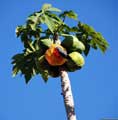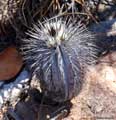The Sempre Vivas National Park is near Diamantina in the state of Minas Gerais. The minuscule village of Inhaí is the geographic reference for the rare visitors coming from Diamantina. It has only one tiny lodge of four rooms, a bar with delicious food (cooked in an old wooden stove) and a general store. No paved roads, pharmacy, newstand, cell phones or internet. Unknown by the scientific community and the general public, the Sempre Vivas is a forgotten haven of incredible beauty and peace.
The park received its name from the abundance of Sempre Vivas it holds. Created in December 2002 in an area of 124,500 hectares, it only exists on paper because the federal government never invested in the necessary infrastructure and personnel to protect the fauna and flora it contains. In fact, the plants and animals are at risk with hunters and extrativism raging freely. Farmers still occupy the land for the corresponding indemnities have not been paid after all these years. The lack of funds and material support rends powerless the environmental authorities which are unable to accomplish their constitutional obligation. Alas, a common scene in Brazilian National Parks.
The biome of the Sempre Vivas is the extraordinary Cerrado. Vegetation is basically that of the Campos Rupestres. The Sempre Vivas has the most spectacular collection of Encholirium I have ever seen. They come in all sizes and astonishing colors.
The Brazilian Cerrado follows the same fate of the original Mata Atlântica of which less than 8% is left. Converted to pasture, agriculture, eucalyptus farms or urban areas, the Cerrado is fast succumbing to the agribusine$$. A recent research led by Conservation International - CI estimates that "only 4.1% of the Cerrado is legally protected. The biome risks disappearing around 2030. Of the original 204 million hectares, 57% have already been completely destroyed and half of the remanining areas is highly altered, possibly unable to serve the purpose of conserving the biodiversity." And more: "The deforestation of the Cerrado is alarming, reaching 1,5% or three million hectares per year. That equals 2,6 football fields per minute. Efforts from all sectors of the society are necessary to reverse this picture."
The destruction of the land - all biomes included - is, as a general rule, bad news to humankind. Did you know that our incompetence in managing natural resources is such that more than 70% of the deforestation of the Amazon ends up as garbage, that is, is simply wasted with no economical value whatsoever? That´s right, of each ten trees felled in the Amazon, seven go to the garbage can. ¹
I visited the Park in August 2009 with Rafael Louzada, a bromeliad specialist of the University of São Paulo, in short USP.
I acknowledge the usual assistance of Domingos Cardoso, Marlon Machado, Harry Luther, Mike Andreas and Derek Butcher. Special thanks to Geraldo and his family of the Fazenda Buritis and Vera of Pousada José Maria.
This is the last chapter covering the Espinhaço Range in the state of Minas Gerais. Next chapters will cover Bahia, with emphasis to the magic Chapada Diamantina. Prepare your heart!
Happy New Year to you and yours!
Oscar - 29th December, 2010.
Bromeliário Imperialis, Rio, Brazil
¹http://www1.folha.uol.com.br/ambiente/824134-mais-de-70-do-desmatamento-amazonico-vira-lixo.shtml
Photos by Oscar Ribeiro
This presentation is best viewed in 1024x768 pixels or larger.
If your resolution is 1024 x 768 or smaller you may need to use the F11 key to view the entire photo.

Aechmea
phanerophlebia |

Aechmea
phanerophlebia |

Aechmea
phanerophlebia |

Aechmea
phanerophlebia |

Aechmea
phanerophlebia |
|

Aechmea
phanerophlebia |

Ananas
ananasoides |

Ananas
ananasoides |

Arbusto |

Arvore |
|

Arvore |

Borboleta |

Calliandra
dysantha |

Capim |

Capim |
|

Carnivorous
plants |

Carnivorous
plants |

Cereus
jamacaru |

Cipo minensis
and Encholirium |

Cipo minensis
and
Uebelmannia
pectinifera |
|

Cipocereus
minensis |

Discocactus
placentiformis |

Discocactus
placentiformis |

Discocactus
placentiformis |

Dyckia ursina |
|

Dyckia ursina |

Dyckia ursina |

Dyckia ursina |

Dyckia ursina |

Encholirium
magalhaesii |
|

Encholirium
magalhaesii |

Encholirium |

Encholirium |

Encholirium |

Encholirium |
|

Encholirium |

Encholirium |

Encholirium |

Encholirium |

Encholirium |
|

Encholirium |

Encholirium |

Encholirium |

Encholirium |

Encholirium |
|

Encholirium |

Encholirium |

Encholirium |

Encholirium |

Encholirium |
|

Encholirium |

Encholirium |

Encholirium |

Encholirium |

Encholirium |
|

Encholirium |

Encholirium |

Encholirium |

Encholirium |

Flor |
|

Flor |

Flor |

Flor |

Flor |

Flor |
|

Flor |

Flor |

Flor |

Lagarto |

Landscape |
|

Landscape |

Landscape |

Landscape |

Landscape |

Landscape |
|

Landscape |

Landscape |

Landscape |

Landscape |

Liquen |
|

Orchidaceae |

Orchidaceae |

Orthophytum
schulzianum |

Orthophytum
schulzianum |

Orthophytum
schulzianum |
|

Orthophytum
schulzianum |

Orthophytum
schulzianum |

Orthophytum
schulzianum |

Orthophytum
schulzianum |

Orthophytum
schulzianum |
|

Orthophytum
schulzianum |

Orthophytum
schulzianum |

Orthophytum
schulzianum |

Passaro (Bird) |

Pilosocereus
aurisetus |
|

Pseudobombax |

Pseudobombax |

Rhynchospora
speciosa |

Sempre Vivas |

Sempre Vivas |
|

Sempre Vivas |

Sempre Vivas |

Sempre Vivas |

Sempre Vivas |

Sempre Vivas |
|

Snake skin |

Snake skin |

Soil |

Tillandsia sp. |

Tillandsia sp. |
|

Tillandsia
streptocarpa |

Tillandsia
streptocarpa |

Tillandsia
streptocarpa |

Tillandsia
streptocarpa |

Uebelmannia
pectinifera |
|

Uebelmannia
pectinifera |

Uebelmannia
pectinifera |

Uebelmannia
pectinifera |

Vriesea sp. |

Vriesea
oligantha |
|
https://fcbs.org/ © Copyright Notice: All photos copyright Oscar Ribeiro, Bromeliário Imperialis























































































































